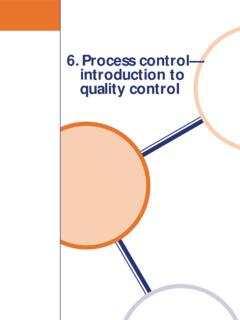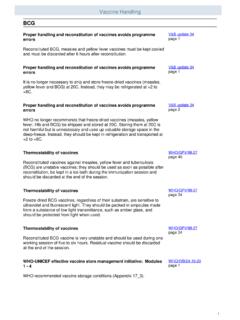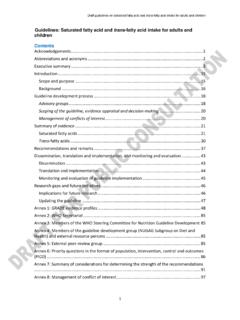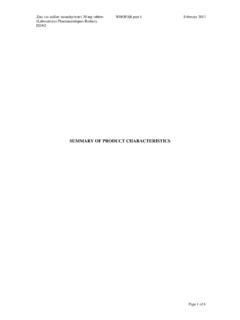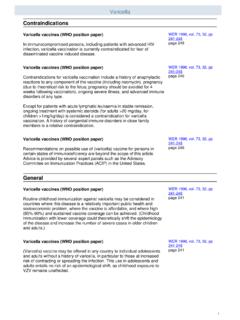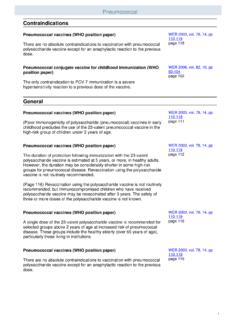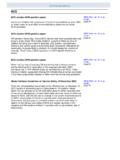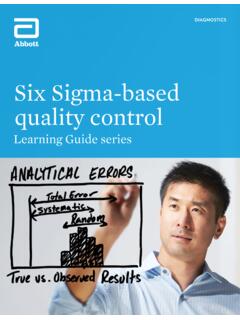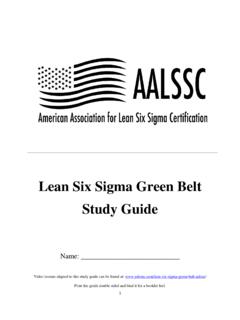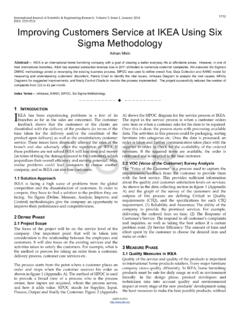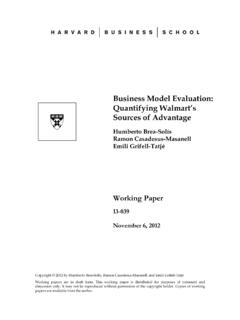Transcription of 15. Process improvement
1 15. Process improvement 15-1: Continual improvement concept Role in quality Process improvement , one of the management 12 quality system essentials, establishes Organization Personnel Equipment system a programme for helping to ensure continual improvement in laboratory quality over time. This continual improvement of the laboratory Purchasing Process Information and processes is essential in a quality inventory control management management system. Documents Occurrence and Assessment management records Facilities Process Customer and improvement service safety Historical W. Edwards Deming is one of the originators of the concept of continual basis improvement , the primary goal of a quality management system. Beginning in the 1940s, he worked with manufacturing and industrial processes, and introduced many of the tools used in quality improvement efforts; his ideas and concepts are used today to produce reliable, quality laboratory results.
2 Deming outlined 14 points for quality, many of which can easily be applied to the laboratory. For the purposes of this discussion, two of his points are particularly important: 1. Create constancy of purpose for improvement . The message here is that there is a need to be constantly working toward making the Process better. 2. Improve constantly and forever. This statement points out that continual improvement will always be a goal. Perfection is never achieved, but we try to get as close to it as possible. Process improvement is something that is never finished, but rather continues on forever . Deming's The Deming Plan-Do-Check-Act (PDCA) cycle shows how to achieve continual PDCA improvement in any Process . cycle Plan identify the problems and the potential sources of system weakness or error.
3 Decide on the steps to be used to gather information. Ask the question, How can you best assess the current situation and analyze root causes of problem areas? Using the information that is gathered through these techniques, develop a plan for improvement . Do implement whatever plans have been developed put the plan into action. 168 Laboratory Quality management System 15-1: Continual improvement concept Plan Act Do Check Check this refers to the monitoring Process . It will be important to assess the effectiveness of the action taken, using focused review and audit processes. If the system weakness is complex, a pilot study may be needed in order to understand all the complexities. After checking , revise the plan as required to achieve the improvements needed.
4 Act Take any corrective action that is required, and then recheck to be sure that the solution has cycle is a continuous Process , so the laboratory will begin again with a planning Process to continue the improvements. This is the continual improvement Process and, in the laboratory, this Process is applied to all procedures and processes that are a part of the path of workflow. ISO Process ISO 15189 [ ] describes a very similar set of activities for achieving continual for continual improvement in the laboratory. These are outlined as follows: improvement identify potential sources of any system weakness or error;. develop plans to implement improvement ;. implement the plan;. review the effectiveness of the action through the Process of focused review and audit.
5 Adjust the action plan and modify the system in accordance with the review and audit results. Laboratory Quality management System 169. 15-2: Tools for Process improvement What is Process A Process is a series of actions or operations contributing to an end. In every improvement ? case, inputs (patient samples) are turned into outputs (patient examination results) because some kind of work, activity or function is carried out. Process improvement is a systematic and periodic approach to improving laboratory quality and the inputs and outputs that glue these processes together. It is a way of solving problems. If there is a problem, however hard to describe, one or more processes needs to be improved. Conventional Many useful techniques have been developed to use in Process improvement , and tools for some have been discussed in other chapters of this handbook.
6 For example, both improvement internal and external audits will identify system weaknesses and problem areas. Participation in an external quality assessment is another useful tool; it allows for comparing laboratory performance to that of other laboratories. management review of all information gathered through these activities should be conducted. In addition, there should be management reviews of the laboratory records on a regular basis; for example, quality control, inventory management and equipment maintenance. These reviews will provide useful information about areas for improvement . Quality plan Monitoring Monitoring Monitoring Quality Internal audit External audit Quality control assessment Opportunities for improvement Quality goal Using information from these reviews and from audits, and through the Process of monitoring the organization's customer complaints, worker complaints, errors, near errors or near misses, opportunities for improvement (OFIs) will be identified.
7 These OFIs will be the focus for corrective action. 170 Laboratory Quality management System 15-2: Tools for Process improvement When conducting audits or evaluating laboratory records, it is important to have a goal or standard of performance. Therefore, quality indicators will be needed and will have an important role to play. The plan leads to the goals; OFIs, which are the result of monitoring, lead to the creation of a new plan, with the Process leading to continual improvement . Newer tools New ideas for tools to use for continual improvement continue to come from the manufacturing industry. Two of these new tools are now being used in laboratory quality improvement . 1. Lean is the Process of optimizing space, time and activity in order to improve the physical paths of workflow.
8 This tool of industry is applicable to laboratories, and many laboratories are currently engaged in creating a lean system. Lean analysis may lead to revised processes and changes in laboratory floor plans. This should save time and financial resources, as well as help to reduce errors in the path of workflow. 2. Six sigma is also a concept that has come to us from the manufacturing industry. This consists of a formal structure for project planning in order to implement change and improvement . In Six sigma , the focus is to move toward reducing error to very low levels. The processes that are described in Six sigma are define, measure, analyze, improve and control. These are similar ideas to those already discussed. The Six sigma concept applies a very structured method for achieving these processes.
9 (This chapter will not explore Six sigma in depth; it is included here so that participants will become familiar with the term. See Chapter 15 reference list for sources of Six sigma information.). Laboratory Quality management System 171. 15-3: Quality indicators Reminder: It is often useful to consider a number of definitions in order to make very clear What is quality? what is meant by a term such as quality. Philip Crosby, in his essays on quality management from the 1960s, defined quality as conformance to requirements, not as goodness' or elegance' . What is a quality Established measures used to determine how well an organization meets needs indicator? and operational and performance expectations is a good working explanation of a quality indicator.
10 Quality indicators are addressed in ISO 9001 and ISO 15189 documents. ISO 9001 [ ] requires that quality objectives should be measurable. Thus, the objectives or indicators must be quantifiable or otherwise capable of analysis, allowing for an assessment of the success of the quality system. ISO 9001 [ ] more specifically requires collecting and analyzing specific information or data upon which one can determine effectiveness and continual improvement . Some of the indicators that are required to be considered include customer satisfaction, conforming to customer requirements for products, counting the number of preventive actions addressed, and ensuring that suppliers are providing materials that will not adversely affect quality. ISO 15189 [ ] states that the laboratory shall implement quality indicators to systematically monitor and evaluate the laboratory's contribution to patient care.

